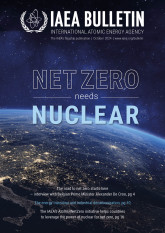SMRs are designed to be factory built and installed on site, thereby reducing costs and shortening construction times, and their relatively small size of typically up to around 300 megawatts (electrical) (MW(e)) per unit may allow for their deployment in areas unsuitable for large reactors. However, the bespoke nature of many nuclear components can lead to bottlenecks in the supply chain, as the manufacture of tailor-made items, together with current inspection procedures, may significantly lengthen the production process.
Moving towards a model of reactor design based on serially produced items and harmonizing requirements among regulators and end users in different jurisdictions could greatly reduce the time and effort required to get SMRs and other advanced reactors up and running.
“Obtaining approval to use custom-built technologies is a difficult and often lengthy process, as nuclear regulators do not currently allow non-nuclear standard industry components for safety applications in nuclear facilities,” says Matheus Abbt, senior advisor for nuclear technology at Swedish power company Vattenfall. “Aligning nuclear safety requirements with relevant industry standards could help overcome supply chain challenges and facilitate quicker deployment of SMRs”.




